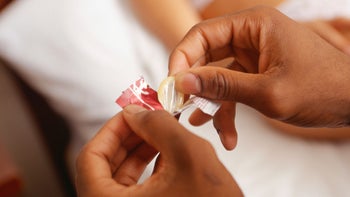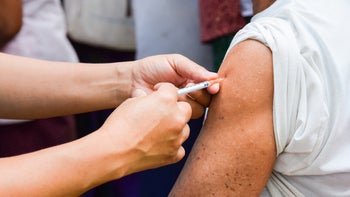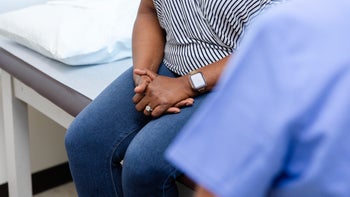
Chlamydia: Symptoms, Causes, and Treatment
Key takeaways:
Chlamydia is one of the most common sexually transmitted infections (STIs) in the U.S.
Chlamydia symptoms can include pain with peeing, discharge from the penis or vagina, and infertility. But some people will have no symptoms at all.
Usually chlamydia doesn’t go away on its own, but you can get rid of chlamydia by taking antibiotics.
Access savings on related medications
Table of contents

Chlamydia is one of the most common sexually transmitted infections (STI) in the world. It’s especially common in women younger than 25 years. But you can have the infection without having symptoms, so diagnosing it isn’t always straightforward.
Chlamydia can cause serious health problems — including infertility — so early treatment is important. But how do you know if you need a chlamydia test or treatment? Let’s take a look at some facts about chlamydia and what you can do to avoid getting it and passing it to others.
What is chlamydia?
Chlamydia is a very common STI caused by the bacteria Chlamydia trachomatis. It can cause infection in both men and women. You can get chlamydia by having vaginal, oral, or anal sex with someone who has the infection. It can also be passed on to a baby during childbirth.
Chlamydia is curable with antibiotics. But, if left untreated, it can lead to serious health complications such as infertility.
How to pick a condom: Condoms are one of the best ways to protect yourself during sex. Explore your options.
At-home testing: Learn how to test for STIs within the privacy of your own home.
STI treatment: Many STIs can be treated or cured with medication. Learn about what to do after a positive test result.
Chlamydia symptoms
Chlamydia is often called a “silent infection” because people often don’t realize they have it. In fact, most people with chlamydia will have no symptoms at all.
When chlamydia does cause symptoms, it can lead to:
Pain or burning sensation with peeing
Discharge from the vagina or penis
Rectal pain or bleeding
Swollen and painful lymph nodes
Eye redness and watery discharge
Sore throat
Painful joints
If left untreated, chlamydia can lead to other problems, including:
Pelvic inflammatory disease
Difficulty getting pregnant
Ectopic pregnancy, or a pregnancy outside the womb
Chronic pelvic or abdominal pain
How long does it take for the symptoms of chlamydia to show up?
Symptoms usually start 1 to 3 weeks after exposure to chlamydia — if they develop at all. Some people develop symptoms several months after exposure.
Read more like this
Explore these related articles, suggested for readers like you.
People who never feel sick can still pass chlamydia to other people during sex.
How do the symptoms of chlamydia differ between men and women?
Many of the symptoms of chlamydia are the same for men and women. But it’s important to note that some symptoms are different.
Women can have heavy menstrual bleeding or pain with sex as symptoms of chlamydia.
Men can develop pain and redness to a testicle — usually only on one side. Men can also develop pain with ejaculation as a possible symptom.
How do you get chlamydia?
The bacteria that causes chlamydia lives in bodily fluids like vaginal fluid and semen. So you can get chlamydia when you come in contact with these fluids. This can happen through:
Vaginal sex
Anal sex
Oral sex
Chlamydia can also be spread to a newborn baby through childbirth. A vaginal delivery has a higher risk of transmitting chlamydia to the baby. But it’s still possible for a baby born through C-section to get chlamydia if the mother has the infection.
Can you get chlamydia from oral sex?
Yes, you can get chlamydia from oral sex. If you have oral sex with someone who has chlamydia, you could develop chlamydia in the throat. This can lead to sore throat, painful ulcers, white patches in the throat, or fever. But you may have no symptoms at all but still test positive for chlamydia with a throat swab.
Can you get chlamydia without having sex, like from a toilet seat?
Chlamydia is transmitted through direct sexual contact with a person who has the infection. So it’s unlikely to catch chlamydia from casual contact like hugging or kissing. You also can’t catch chlamydia from sharing things like towels or utensils. And — while you might worry about the risk of using a public restroom — rest assured that it would be almost impossible to catch chlamydia from a toilet seat.
How do you diagnose and treat chlamydia?
Diagnosing chlamydia can be tricky since most people will have no symptoms. That’s why it’s important to get regular screening if you are in a high-risk group. The CDC recommends yearly chlamydia testing for the following groups:
Sexually active women under the age of 25
Sexually active women older than 25 years with any risk factors (like multiple partners, new partners, or a partner with a known chlamydia infection)
Men who have sex with men
People with HIV
A healthcare professional can check your urine sample for chlamydia. Or they can use a swab that looks like a Q-tip to send a sample from your vagina, penis, or rectum. You can also collect one of these samples yourself at home using an at-home STI test kit.
If you test positive for chlamydia — try to stay calm. Chlamydia is completely curable with antibiotics. Your primary care provider will likely prescribe one of these antibiotics:
If you need treatment for chlamydia, make sure to get retested 3 months after finishing your antibiotics. This will make sure that the antibiotics worked.
Does chlamydia go away on its own?
Chlamydia usually doesn’t go away on its own. One study found that the infection resolved without treatment for 1 in 5 people with chlamydia. But this means that about 80% of people need treatment to get rid of it. And since untreated chlamydia can lead to serious health issues, you should not wait for it to go away on its own.
Untreated chlamydia infections in women can cause pelvic inflammatory disease (PID). In some cases, it can lead to PID a few days after getting chlamydia. Other times it can take up to a year to develop PID symptoms after chlamydia. PID causes damage to female reproductive organs.
People who have PID may develop:
Infertility (inability to become pregnant)
Tubo-ovarian abscess (a collection of pus in the fallopian tubes and/or ovaries)
Chronic pelvic pain
Keep in mind that people who’ve never had chlamydia symptoms can still get these complications.
How long does chlamydia last?
Chlamydia can take up to 7 days to resolve after you start antibiotics. You should avoid any kind of sex until 1 week after you’ve started antibiotics. And wait until your symptoms have resolved before having sex.
If you test positive for chlamydia, your partner — and any sexual partners from the past 60 days — should be treated with antibiotics. It’s possible to get chlamydia more than once, especially if your partner isn’t treated. So make sure your partner also gets treatment — that way you won’t pass it to each other.
How to protect yourself against chlamydia
There’s a lot you can do to keep yourself safe from chlamydia while you’re sexually active:
Get tested for chlamydia at least once a year. Since most people with chlamydia don’t have symptoms, the CDC recommends that sexually active people get tested regularly.
Use barrier protection for all sexual activity. Barriers, like condoms, keep chlamydia from being passed from person to person. Chlamydia can be passed in all bodily fluids, so make sure to use condoms during all types of sexual activity.
Make sure your partner gets tested. Have an honest conversation with your partner(s) — encourage them to get tested for chlamydia. This will help protect you and also keep them safe from chlamydia complications.
Take all your antibiotics. If you get diagnosed with chlamydia, make sure to finish all the antibiotics prescribed — even if you feel healthy and don’t have symptoms.
The bottom line
Chlamydia is very common, especially in sexually active people between 18 and 29 years old. Most people with chlamydia don’t have any symptoms, but they can still have complications and pass the bacteria to others. The good news is that antibiotics can cure chlamydia. If you’re sexually active, use barrier methods and get tested for chlamydia regularly to keep yourself safe.
Why trust our experts?



References
American College of Obstetrics and Gynecology. (2018). Tubal ectopic pregnancy.
Bell, T. A., et al. (1994). Risk of perinatal transmission of Chlamydia trachomatis by mode of delivery. The Journal of Infection.
Centers for Disease Control and Prevention. (2023). Chlamydia – CDC fact sheet (detailed).
Centers for Disease Control and Prevention. (2021). Chlamydia treatment and care.
Centers for Disease Control and Prevention. (2024). Sexually transmitted infections treatment guidelines, 2021.
Centers for Disease Control and Prevention. (2022). Chlamydia – CDC fact sheet.
de Voux, A., et al. (2016). Notes from the field: Cluster of lymphogranuloma venereum cases among men who have sex with men. Morbidity and Mortality Weekly Report.
Geisler, W. M., et al. (2013). Spontaneous resolution of genital Chlamydia trachomatis infection in women and protection from reinfection. The Journal of Infectious Diseases.
Papp, J. R., et al.. (2014). Recommendations for the laboratory-based detection of Chlamydia trachomatis and Neisseria gonorrhoeae. Morbidity and Mortality Weekly Report.
Patel, C. G., et al. (2018). The proportion of young women tested for chlamydia who had urogenital symptoms in physician offices. Sexually Transmitted Diseases.
Planned Parenthood. (n.d.). Chlamydia.
Utah Department of Health. (n.d.). Pelvic inflammatory disease (PID).
U.K. National Health Service. (2021). Symptoms: Chlamydia.
World Health Organization. (2023). Sexually transmitted infections (STIs).





























